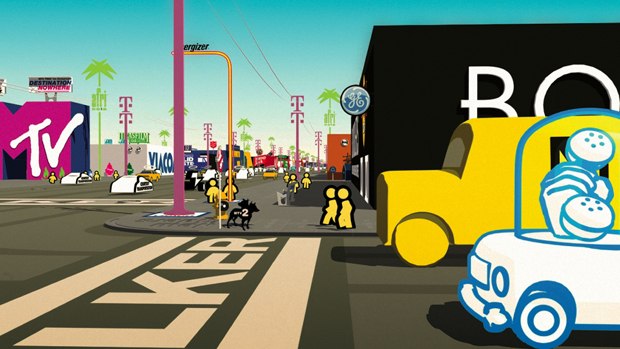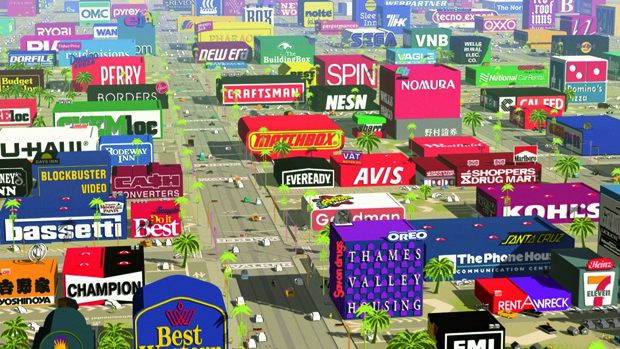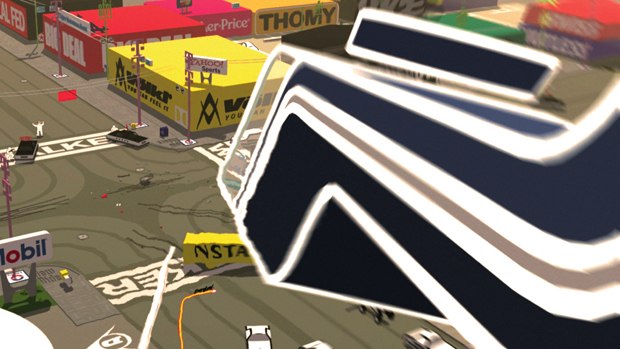The Logorama directing trio explains how it crafted an iconic blockbuster around iconic brands.
Check out Logorama in the 2010 AWN Oscar Showcase!
Logorama is undoubtedly the most audacious Oscar nominee: A gun-toting, foul-mouthed Ronald McDonald? A sexy Esso Girl? A heroic Michelin Man? An edgy Bob's Big Boy? Four years in the making by the French collective, H5 and produced by Autour de Minuit (with financial assistance from Mikros Images and Addict Films), I spoke with Hervé de Crécy and Francois Alaux, who have gone solo, and separately with H5 co-founder Ludovic Houplain.
Bill Desowitz: How did you come up with Logorama?
Ludovic Houplain:
The genesis of the concept first arose when Antoine Bardou-Jacquet and I collaborated on a video for Alex Gopher called The Child that was based on the idea of creating New York City completely out of logos.
Hervé de Crécy: The Child became a world made with only type. So everything is made out of words, typography, so from there, we knew it was possible to build a world with just signs.
LH:
After that we proposed a music video for Télépopmusic, Da Hoola. We realized that we could apply a similar principle but develop the concept further. Our world can be represented with logos. They can symbolize everything: characters, animals, vehicles, plants, graphic shapes… but the idea never took off.
And then there was an opportunity to work with George Harrison, who wanted to make a video about consumerism. And we proposed a world with logotypes and he was enthusiastic, but the music label wanted this concept but with fake logos, and for us it was impossible. You lose the concept and you lose the power. Then Harrison passed away and the idea with him.
HDC:
Then we met producer Nicolas Schmerkin through festivals and we talked about this idea of making a film with logotypes and he thought the idea was brilliant, so he proposed to be the producer of the short and he went to see public firms and many other financiers. And then we went to see Mikros Image, the post-production company in Paris, where we've done many commercials and music videos, and they liked the idea and they invested a lot in the project because everyone worked almost for free, and they spent two -and-a-half-years to make all the animation.
Francois Alaux:
And Ludovic, Hervé and I also kept some money from works we did before to continue the project because it took three years to make, and we had to pay the guys working on animation and rendering. And all the sound design and the dialogue were produced in LA. RSA helped us a lot, especially their department, Little Minx, run by producer Rhea Scott, who helped us work with [screenwriters] Gregory Pruss, Andrew Kevin Walker and even David Fincher.
BD: What were their contributions?
HDC:
They loved the story and Pruss and Walker helped push the dialogue and made it funny and cynical. They worked on it for three weeks. And Walker voiced Hot and Spicy and Fincher voiced the original Pringle.
BD: So, how did you handle the rights issue?
HDC:
We didn't think about the rights -- we weren't looking to make money. We just wrote the story and wanted to make a good film. We weren't against the brands: we love logotypes. It's like the best casting in the world to make the biggest blockbuster movie. And, of course, there is some chemistry between logotypes and some action that happens -- that's life.
BD: Have any of these corporations come after you?
LH:
No, they haven't. Actually, it's more of the opposite with some brands asking why they aren't in the short.
BD: And what was it like researching and compiling all the logos?
LH:
We compiled a database of 45,000 logos. And at the end we only used 2,500. And then we had to draw all the logos from all the different angles and modeling in 3D. And at the same time we worked on an animatic. And we worked on the edit for each scene in order to place all the modeled logos in different camera angles.
HDC:
We made a first version of the film with basic After Effects animation. Plus we used ideas from Hollywood blockbusters just to get the right cameras, the right action, etc. From there we did the edit and were ready to start the animation when we finished these steps, and that's the moment when we went with Mikros Image. And so we gave our 2D animatic to the animators -- we don't animate ourselves. We just directed all the animation and also for the animation we used Rotoscopic-based animation, which means we filmed ourselves doing basically all the movements and playing all the characters in the film and gave that to the animators so they could have a reference and also to reinterpret our moves to make it work with characters that don't necessarily have a human shape.
For example, it was funny for The Pringles. We put them into situations where you don't have to see their bodies, so whether they are driving a truck or sitting at the table, we used every trick to make it possible to have them without being weird, because if we had to see them walk on their hands, it would've been really bizarre.
And also we spent a long time with the animators to redo all of the cameras because we didn't want it to look too cartoonish but real: our reference was live-action blockbusters. The idea was to use cameras that were not from animation but could have been possible.
FA:
They are references from John McTiernan movies or Tony Scott or Ridley Scott. There is some stuff from Black Hawk Down in the film. But it was important for us to use a universal language because we were in a very bizarre world of logotypes. And we wanted the audience to stay in the story.
HDC:
Because there are so many levels of understanding in Logorama but it had to work as a story first. What we like is when people just dive into the story and at some point realized that it's a world made out of logos. They don't even have the time to concentrate on the logos. And we wanted the story to be as iconic as the logos themselves. The narrative is also a logotype because it uses all the tricks of Hollywood.
LH:
The whole film is filled with logo associations, playing on the opposition of signification, and the competition between brands. It’s really very playful. We allowed ourselves everything that was forbidden on TV or in films or advertising. Everything was allowed. There were no limits.
BD:
And what software did the animators use?
HDC: Maya, but Mikros used a very special rendering system for the logotypes, because, as you know, there is a kind of outlining and a lot of complexity. And in the same frame, you have to show logotypes in 3D. And so you have different types of shaders at the same time. And we spent about a year trying to figure out how we wanted to show logotypes in the film: when to use shadow and when not to use shadow.
FA:
And this process was complex because logotypes come from different designers. Some have big outlines, others don't have any outlines. Some use shadows, some don't.
HDC:
And when you use the Michelin guy in a copter or Ronald McDonald in a a van or using the weapon, you have to think about the best combination of logotypes so you have something easy to understand.
BD: What have the different cultural reactions been like?
HDC:
It's so different, depending where you're from. For example, when you see Ronald shooting the cops, his weapon is the logotype of the Red Faction Army, the German terrorist group of the '70s. And a lot of Americans ask why he's using the Royal Air Force and I explain that it is something completely different.

Logorama is uncensored: everything that is forbidden on TV or in films or advertising became possible.
BD:
Since leaving H5, what are you both working on next?
FA:
We're doing a 30-minute film for a videogame company that's linked to the Tom Clancy franchise. It's live action but it's a good opportunity to work in a longer format. Logorama was new for us too after working on commercials and music videos.
BD: And, you, Ludo, any more shorts at H5?
LH:
We are doing more commercials and exhibitions and a new short as well. The action takes place in Russia and outer space and is an interpretation of Russian Constructivism as if it was created today. Obviously, it is totally different from Logorama. It's about dehumanization and also plays with the roots of cinema.
BD: Who is doing the animation?
LH:
Forêt Bleue, which worked on I, Robot.
BD: And the name of your short?
LH: This is the End.
Bill Desowitz is senior editor of AWN & VFXWorld.












